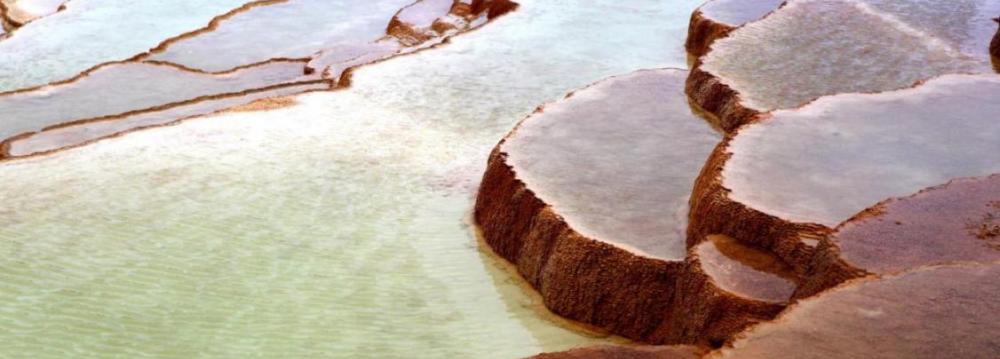Looking for a day trip out of Tehran with the additional delight of witnessing a natural wonder? Something that amazes you and inspires you at the same time? How about colorful stone terraces filled with sparkling mineral water glowing in the sun light? Welcome to Badab-e-Surt, Mazandaran Province, a range of stepped travertine terrace formations created as a result of flowing mineral water over thousands of years.
The water stored in the terraces gets clearer as it flows to the bottom terraces depositing the heavier minerals in the top terraces. The result is a number of orange, red and yellow-colored pools shaped as a naturally formed staircase. The beauty of these terraces and the location of the spring on the outskirt of the mountains as well as the surrounding sceneries provide a wonderful and fascinating scene especially during sunset, according to Fararu.
Badab-e-Surt’s terraces are made of travertine, a sedimentary rock deposited by flowing water from two active mineral springs, located at 1,840 meters (6,040 ft) above sea level. It is believed that the mineral springs were created during the Paleocene era, at the same time as the latest folds in the Alborz mountain range. The first spring contains very salty water that gathers in a small natural pool; its water is considered to have medicinal properties, especially as a cure for rheumatism and some types of skin diseases and skin conditions. The second spring has a sour taste and is predominately orange mainly due to the large iron oxide sediments at its outlet.
Badab is a Persian compound of ‘Bad’ meaning gas, and ‘ab’ meaning water, translating to “fizzy water”, which refers to the spring’s carbonated mineral water. Surt is an old name for the Orost village and a Persian word meaning intensity.
How to Get There
Located 95 kilometers south of the city of Sari in the northern province of Mazandaran and 7 kilometers west of Orost village, The total distance from Tehran to Badab-e-Surt is 370 kilometers; making it an ideal place to visit over the weekend.
The Orost village and Badab-e-Surt Springs are easily accessible via road through both Semnan and Mazandaran provinces. Both routes are well paved except for the last few kilometers which is dirt road but smooth. While the road passing through Semnan is of better quality, the Mazandaran route is more popular due to the natural beauties of this province.
The Semnan route passes through Semnan city; driving towards Mahdishahr county, one must continue towards Shahrmirzad county and Fulad Mahalleh to finally reach Orost village. While travelling through Mazandaran Province, one must first go to Sari via road or air and then drive towards Kiasar county, one of the most beautiful jungle routes in the northern province, to reach Orost village.
Similar Places Around the World
Travertine formations such as Badab-e-Surt are found only in six sites across the world, including Pamukkale in Turkey, Huanglong in China, Mammoth Hot Springs in USA, New Zealand’s Pink and White Terraces, Italy’s Bagni San Filippo and Mexico’s Hierve el Agua.
New Zealand’s Pink and White Terraces and Te Tarata in Maori were for long thought to have been completely destroyed by a violent volcanic eruption in 1886. But some parts of the terraces were rediscovered in February 2011 by a team of researchers.
The travertine terraces of the Mammoth Hot Springs in Yellowstone National park in America are formed from limestone whose features constantly and quickly change due to the rapid rate of deposition.
Pamukkale (meaning “cotton castle” in Turkish) is a natural site in Denizli Province in southwestern Turkey. The city contains hot springs and travertine terraces of carbonate minerals left by the flowing water.
Huanglong (literally yellow dragon) is a scenic and historic area in the northwest part of Sichuan, China. This area is known for its colorful pools formed by calcite deposits.
National Heritage
Badab-e-Surt Springs were registered as Iran’s second natural site in 2008. Damavand Mount, Badab-e Surt Springs and Abarkouh Cedar were three natural sites registered by Cultural Heritage Organization in 2008.
The environmentalists and nature lovers have repeatedly expressed concern regarding protection of this natural wonder, citing that despite being registered as a natural site, the authorities have not taken any measures to protect springs and terraces from the visitors who are not aware of how fragile these millenia-old terraces are.
Given the lack of protective measures, even as little as installing an information board near the site, it is left to the villagers to protect the springs they have cherished for so many years. It is quite a common site to see village boys ask the visitors not to step on the terraces for taking a photograph or just dipping in the water. This is while the visitors to Pamukkale in Turkey are not allowed access to the site and must purchase tickets only to see the springs from a distance.


